Magnetohydrodynamic double-diffusive peristaltic flow of radiating fourth-grade nanofluid through a porous medium with viscous dissipation and heat generation/absorption
- PMID: 37567889
- PMCID: PMC10421899
- DOI: 10.1038/s41598-023-39756-5
Magnetohydrodynamic double-diffusive peristaltic flow of radiating fourth-grade nanofluid through a porous medium with viscous dissipation and heat generation/absorption
Abstract
This article focuses on determining how to double diffusion affects the non-Newtonian fourth-grade nanofluids peristaltic motion within a symmetrical vertical elastic channel supported by a suitable porous medium as well as, concentrating on the impact of a few significant actual peculiarities on the development of the peristaltic liquid, such as rotation, initial pressure, non-linear thermal radiation, heat generation/absorption in the presence of viscous dissipation and joule heating with noting that the fluid inside the channel is subject to an externally induced magnetic field, giving it electromagnetic properties. Moreover, the constraints of the long-wavelength approximation and neglecting the wave number along with the low Reynolds number have been used to transform the nonlinear partial differential equations in two dimensions into a system of nonlinear ordinary differential equations in one dimension, which serve as the basic governing equations for fluid motion. The suitable numerical method for solving the new system of ordinary differential equations is the Runge-Kutta fourth-order numerical method with the shooting technique using the code MATLAB program. Using this code, a 2D and 3D graphical analysis was done to show how each physical parameter affected the distributions of axial velocity, temperature, nanoparticle volume fraction, solutal concentration, pressure gradients, induced magnetic field, magnetic forces, and finally the trapping phenomenon. Under the influence of rotation [Formula: see text], heat Grashof number [Formula: see text], solutal Grashof number [Formula: see text], and initial stress [Formula: see text], the axial velocity distribution [Formula: see text] changes from increasing to decreasing, according to some of the study's findings. On the other hand, increasing values of nonlinear thermal radiation [Formula: see text] and temperature ratio [Formula: see text] have a negative impact on the temperature distribution [Formula: see text] but a positive impact on the distributions of nanoparticle volume fraction [Formula: see text] and solutal concentration [Formula: see text]. Darcy number [Formula: see text] and mean fluid rate [Formula: see text] also had a positive effect on the distribution of pressure gradients, making it an increasing function.
© 2023. Springer Nature Limited.
Conflict of interest statement
The authors declare no competing interests.
Figures




















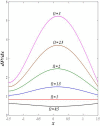
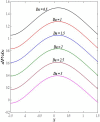


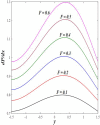
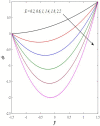
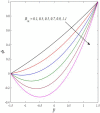

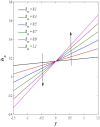
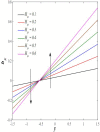






References
-
- Latham TW. Fluid Motion in a Peristaltic Pump (Master Thesis) MIT; 1966.
-
- Akram S, Razia A. Hybrid effects of thermal and concentration convection on peristaltic flow of fourth-grade nanofluids in an inclined tapered channel, applications of double-diffusivity. Comput. Model. Eng. Sci. 2021;127:901–919.
-
- Kothandapani M, Pushparaj V, Prakash J. Effect of magnetic field on peristaltic flow of a fourth-grade fluid in a tapered asymmetric channel. J. King Saud Univ. Eng. Sci. 2018;30(1):86–95.
-
- Abdulhadi AM, Ahmed TS. Effect of magnetic field on peristaltic flow of Walters–B fluid through a porous medium in a tapered asymmetric channel. J. Adv. Math. 2017;12:6889–6893.
-
- Asha SK, Deepa CK. Peristaltic flow of a third-grade fluid accounting Joule heating and magnetic field effects in an asymmetric channel. World Sci. News. 2019;137:1–17.
LinkOut - more resources
Full Text Sources

